Introduction
Purpose and objectives of master's work
Background Master's thesis
1 Analysis of existing structures and the rational choice of technical solutions
1.1 The design of double roller press IFM NАN of Ukraine
1.2 swath briquette press firm "Keppern" (Germany)
1.3 Experimental swath briquette press design DonNIICherMet (БПЭ - 4M)
1.4 Swath press for briquetting of coal, which implements the principle of a multistage seal
1.5 Swath press for briquetting loose materials
1.6 Swath press with a three-stage compression
2 Description of the improved design double roller press
3 Specifications constructed laboratory press
References
Introduction
Growing competition, increasing environmental requirements, as well as the complexity of the extraction and preliminary preparation of raw materials — these and other factors are placing greater demands on the metallurgical industry in Ukraine. Therefore, improvement of traditional and development of new technologies is a prerequisite for sustainable development industry. New intensive technologies and processes are not only placing high demands on the quality of raw materials, but also require new types of him. In the context of increasing scarcity of low-sulfur coking coal and the intensification of increasing importance will become integrated ore–fuel materials, and processes of the prior partial restoration increasingly be applied in the preparation of raw materials. Traditional methods of agglomeration and raw material agglomeration okatyvaniem largely exhausted its reserves and capabilities. Thus, under the present technical level is difficult to get bonded agglomerate or solid pellets with a high content of free carbon. At the same time such materials are prepared by briquetting. However, the briquettes in the steel industry has not yet received due recognition. The share of raw materials, okuskovannogo briquetting, remains at 2%. Basically it briquetted metallized materials, fluxes and ferro-alloys for steel production. Briquetting can develop successfully in the event that it will be used in metallurgical industry, where its advantages are especially obvious. This primarily relates to the disposal of waste dust [1]. Thus, progress in the field of briquetting and demand for raw materials with new properties are reviving interest in briquetting as a method of sintering iron ore.
Purpose and objectives of master's work
The basic unit of process equipment for the production of briquettes is a briquette press. Its purpose — to provide integrated ore–fuel materials, metallized sinter solid pellets with a high content of free carbon [2].
purpose of work — research briquetting process and the development of methods of calculating the parameters of the press for making briquettes.
To achieve this goal it is necessary to accomplish the following tasks:
— analyze the advantages and disadvantages of existing designs of briquetting presses;
— select the best technical solution;
— design and manufacture a physical analogue enhanced the press;
— conduct laboratory investigations of the parameters of the press;
— developed methodology for calculating energy–power characteristics of the press.
Background Master's thesis
In recent years the task of creating a reliable domestic presses for briquetting melkofraktsionnyh raw materials and industrial wastes is becoming increasingly pressing. This is due not only to increased interest in briquetting, but also to the fact that in Ukraine and CIS countries there are practically no experience in the design and manufacture of roller briquetting presses, there are no companies that specialize in their manufacture. A small number of roller presses domestic production, working at various companies, designed and manufactured by various non-specialized enterprises. In this regard, there is no uniform approach to the principles of calculation and design of the presses and their main units. Insufficiently complete account of the properties of charge materials and technology features of their briquetting leads to inconsistency of design and the actual loads encountered in their major hubs and drive [2].
1 Analysis of existing structures and the rational choice of technical solutions
Currently, there are many different designs and configurations of roller briquetting presses, which in no small degree due to briketiruemym material, ie raw material for briquettes given shape and mechanical properties. Iron and Steel Institute of NASU (HMI), which has considerable experience in developing the technology of briquetting of different charge materials, create roll press with capacity from 0,5 to 15 t / h, whose design has the simplicity, reliability and ease of use. Calculation of the parameters of presses made on the basis developed in the HMI technique that takes into account the physical - mechanical properties of the blends, the conditions of capture batches rolls, the mechanism of stress in the deformation and the effect of the forms configuration element to the parameters of briquettes.
1.1 The design of double roller press IFM NАN of Ukraine
The swath press (Fig. 1) represents a design Housingless type and consists of the following units: two working rolls with chocks, loading device, the device clamping rolls and protect the press from overload, the press and drive frame. Linked with the press drive and boot device on a common frame.

Work rolls (drive 1 and drive 2 is not installed in the bearing supports (pads). Airbags drive rolls are stationary and rigidly fixed to the frame 3. Airbags NDE roll frame pivotally connected to the finger 4 and have the opportunity to travel in excess of a given effort pressing. movable and stationary pads are interconnected in pairs by means of damping devices 5. Damping devices are a set of disc springs installed in the cylindrical housing. Pre-tightening spring set set point effort in the damper, you need to balance the efforts of the spacer, which arises between the rollers in the process Briquetting of the mixture. Tightening the springs made with nuts 7 and can be carried out outside the press. Fixing screws is performed using the locknuts and lock washers. Puffs springs depends on the efforts of the pressing and is defined by the attached in your passport press the load chart. The gap between the working surfaces of rolls installed and adjusted with nuts 6 on the damper rods covering biscuits hinged supports the non roller. Above a given compaction effort (effort provisional tightening springs), including by ingestion of foreign objects mezhvalkovoe space, non-drive roller is rejected and the clearance can be increased to 15 mm with the restoration of the working gap after reduction efforts.
Rolls equipped with interchangeable circular bandages with profiled working surface. Erection and dismantling of the ties made with wedge–shaped rings. Boot device 8 consists of a welded funnel placed on top of the roll gap and mounted on a special frame, covering the surface of the tires. Adjustment of the material in mezhvalkovoe space by means of gate 9. Boot device is installed and secured to the frame 3. The structure of the drive includes the following equipment: motor 10, toothed chain transmission 11, gear 12, synchronizing gear transmission 13 with a half–coupling 14. From the electric motor torque be passed through a chain transmission for high–speed shaft of the gearbox and then through the adapter drive shaft of the press, which is a synchronizing gear (with the largest module of the tooth) transfer drives the non–drive shaft. Press can be installed on a foundation, and on the metal with the possibility of placing him under a tank for collection of finished products (briquettes) [2].
1.2 Swath briquette press firm "Keppern" (Germany)
Such a design has the press firm Keppern (FRG) with a capacity to charge for coking up to 90 t / h (Fig. 2), but it has its own, and some differences.

Instead of numerous bolts, on which build frames, used connections on the pins, diameter of rolls up to 1400 mm for the lateral movement of rack is used with hydraulic cylinders that are located at the base of the bed between the side struts, synchronizing open gears located in the middle of the barrel roll. Traditional form of frame has a U-shaped bottom. Split Line runs along the center line of roller block press. This design provides rigidity and strength of frame, but the replacement of her worn-out rolling blocks involves considerable time [3].
1.3 Experimental swath briquette press design DonNIIchermet (БПЭ–4M)
The swath briquette press for sintering materials with low bulk weight was established in DonNIIchermete. Prototype of the press is made in conjunction with the Magnitogorsk Metallurgical Combine, and tested at the agglomeration of active lime fines. Press БПЭ–4M (БПО–600) has a bed with reclining on one side cheek (Fig. 3). The diameter of the rolls of the press is 600 mm profile. Performance of finished briquettes to 3 cubic meters per hour [3].
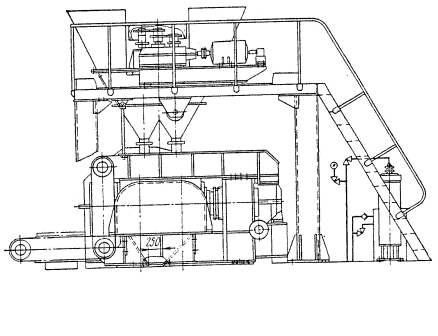
1.4 Swath press for briquetting of coal, which implements the principle of a multistage seal
In the literature known to the technical and constructive solutions roller presses for briquetting, implementing the principle of multi–stage seal. Fig. 4 shows the scheme mnogovalkovogo press for the briquetting of coal [5]. Fine material passes through the hopper 1, the dispenser 2 and evenly fills the trough rotating pressing roller 3, acting at first under the smooth transmission of pressing rolls 4, and then under the profile of pressing roller 5. As we move the material under the pressure rollers 4 the degree of compression tape is increased to the specified parameters, and under the core, pressing roller 5 reel pre-profiled. Through Sept. puller tape is removed from the press roll 3 and the guide rollers 8 goes to the press rolls 6, which finally profiled. They are forming specialized tapes that forcibly removed from the grooves of the rolls puller and sent to the toothed roller 7, in which the tape is divided into individual briquettes. Next they go changeover valve 10 in the funnel for briquettes.
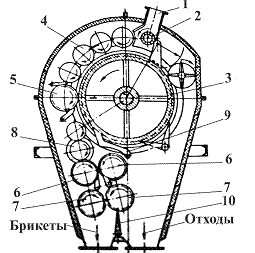
1.5 swath press for briquetting loose materials
Another design roller press with multi-stage seal is shown in Fig. 5.
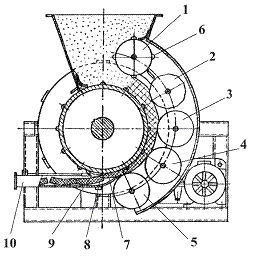
Fine material is formed along the working surface of the roller 7 and the pre–sealed roller 1 with the protrusions 6. Further compressing the material by the rolls 2, 3 and the rollers 4 and 5. The protrusions 8 on the basis of the matrix form indentations in the tape briquette, which facilitates its separation into individual briquettes. Extract from the matrix of compacted material is carried out both by the buoyant forces of the elastic component of the expansion of operating in a curved area, and fork-knife 9. Lessons from the matrix pellets pushed into issuing the tray 10.
Press operation is carried out as follows. The bulk material feeder–dispenser 5 is fed into the space between the sealing rollers 3, 4, whose surface has a smooth shape. Depending on the angle of rotation of the rolls, the material involved in the deformation region, from the original powder state at the center line of the rolls into a compact tape [6].
1.6 swath press with a three–stage compression
Scheme roller press shown in Fig. 6, is an improvement on the well–known double roller press [7].
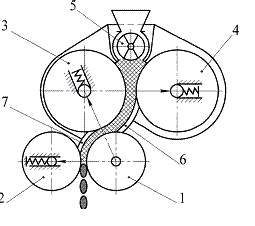
Due to the backwater and the forces of friction tape on the guide 6 is involved in the deformation zone in the second stage of rollers 1 and 3. Next, tape the guides in July moved into a zone of compression between the rollers 1 and 2, in which the tape okuskovyvaetsya to the state of the briquette.
Despite the promise of existing developments, including the above, it should be noted that the wide introduction in practice of briquetting presses design with multistage seal is not received. It is caused primarily insufficient study of the mechanism of gradual deformation of the charge. Theory briquetting process under such a scheme of the deformation zone is not developed, there is no method of calculating the basic technology, strength and structural parameters of the process and equipment, it is impossible to predict the result of [8].
Recently, in designing roller briquetting presses main focus is to improve their layout and the creation of a block design, providing a dramatic reduction in downtime briquette plants at replacement of defective parts and components, conducting preventive examinations related to the partial dismantling installations or briquette press.
2 Description of an improved double roller press design
After analyzing the existing design double roller presses, and eliminating most of the shortcomings, has been developed an improved design of the press. (For research and obtain the dependence of torque from the spacer efforts in pressing was slightly modified design of the drive rolls).
Press includes working stand (Fig. 7), consisting of two frame 1 open, interconnected by a lid 5.
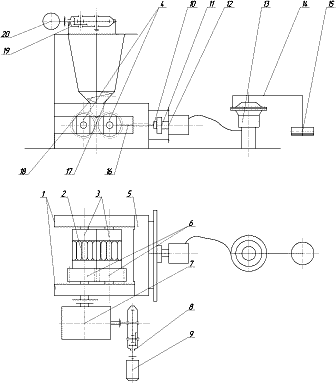
Inside the cage there are two rolls 3, installed in the bearing supports 4, the body which have the possibility of relative movement along the rail bed.
On the cylindrical surface of each of the rolls in the middle of its parts are the cell 2, with closure which, for a synchronous rotation of the rolls, briefly formed a cavity to form briquettes. Synchronizing the rotation of rolls provided with toothed wheels 6, set near one of the bearings and located in the engagement. Support one of the rolls is fixed with respect to the trails, and it is equipped with pin to transfer torque, ie is leading. Its rotation carries the drive, consisting of a motor 9, a fast two-stage cone — a cylindrical gear 8 and low–speed worm gear 7.
For pressing the driven roller to the drive press is equipped with a hydraulic system, which includes a discharge 13 and ram 12, connected by a tube. The working fluid pressure in the working cylinder creates a set of goods 15, acting through the lever 14 on its stock. Stem power cylinder 11 through the crossbeam 10 acts on the rods 16, mounted to the channel cover and the free ends rest against the pillow bearings driven roll. The hydraulic system not only allows you to adjust by pressing the rolls by changing the quantity (mass) is hung on the arm of goods, but also prevents the failure of the gears in the event of contact between the rolls of foreign objects, as it enables in case of dangerous spacers effort unlock gearing.
Press also provided with the device pre–crimping the source material briquettes. This device is placed on the crate and consists of a hopper 17, having a truncated cone shape and is coaxially installed on the rolls in the area of ??closing their cells. Inside the hopper into the lower part of the vertical shaft mounted auger 18, having a conical shape. The rotation of the shaft auger drive ensures that consists of a worm motor–reducer 20 and the low–speed two–stage cone — cylinder gear 19.
To control the energy–power parameters of the drive shaft press between his fast–moving and slow–speed gearbox instead of the usual clutch is established a special endowed tenzorizistornym converter included in the measurement system, allowing real–time display of transmitted torque. On the traverse, distributes force between the push rod that touches pillow bearings driven roller, and mounted strain gauge transducer, a part of measuring and monitoring systems, and fixing the total force developed by hydraulic power cylinder. While simultaneously recording the signals from both transmitters, you can get objective information about the dependence of the torque of the developed drive press during the formation of briquettes, and spacers of the forces acting on both the roll.
The calculation of basic parameters and forces acting in the course of the press, was produced by the approximate method [4]. With the help of a computer program was made KOMPAS 3D three-dimensional model of the device (Fig. 8).
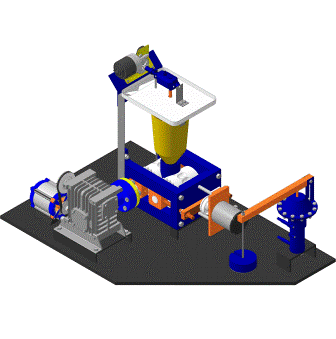
(animation: volume 223 kb, frame 11, number of repetitions cycles 14, delay between frames 100 ms)
3 Technical characteristics of the constructed laboratory press
Based on drawings obtained using three–dimensional model and calculation of key energy-force parameters was designed and constructed a physical laboratory model of double roller presses for briquetting of secondary materials (Fig. 9).
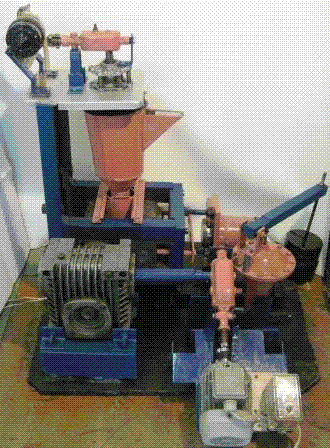
Specification laboratory double roller press:
— briketiruemy material — fine fraction of coal dust;
— Press capacity 110 kg / h;
— briquette mass 0,02 kg;
— force in the pressing of 2300 N;
— power drive rollers 120 W;
— drive power prepressing 30 W.
In writing this essay master's work has not yet been completed, but only prepared laboratory–scale plant to the experimental studies. Final Completion: January 31, 2012. Full text of the work and materials on the subject can be obtained from the author or his manager after that date.
References
- Брикетирование как полноправный метод окускования металлургического сырья/ В.В. Ожогин, А.А.Томаш, И.А. Ковалевский и др.// Металлургические процессы и оборудование.-2005. - №2. – с.54-58.
- Носков В. А. Валковый пресс для брикетирования мелкофракционных отходов производства и сырья// Металлургич. и горноруд. пром-ть. – 1999. - № 2,3. – с.100-102.
- Зидельман Л. П.// Чер.металлургия: Бюл. ин-та «Черметинформация», 1988. Вып.8. с. 2-12.
- Методика расчёта робочих параметров шнекового дозатора вертикального типа/ С.П. Еронько, В.М. Богацкий, С.В. Быковских и др. //Теория и практика металлургии. – 2002. - №5,6. - с.95-101.
- А. с. №1473246 (СССР) / В.А.Генетов, М.Г.Скляр, Э.И.Торяник, А.А.Тараканов, В.Н.Шмадченко, Ф.С.Щелкунов Опубл. в Б. И., 1991, №22.
- А. с. №1189686 (СССР) / Л.С.Грешнов, И.И.Фетисов, В.Ф.Брыкалин, В.В.Борисейко, Н.П.Марук Опубл. в Б. И., 1988, №40.
- А. с. №2190877/27 (СССР) / М.Д.Петров Опубл. в Б. И., 1977, №9.
- Носков В.А., Ващенко С. В. Об использовании принципа многоступенчатого уплотнения при брикетировании мелкофракционных шихт // Фундаментальные и прикладные проблемы черной металлургии: сб. научн. тр. Выпуск 4. К.: Наукова думка. – 1999. – С. 285.
© Starostin Аlexander, DonNTU 2011

 || DonNTU >
Master's
portal of DonNTU ||
|| DonNTU >
Master's
portal of DonNTU ||
